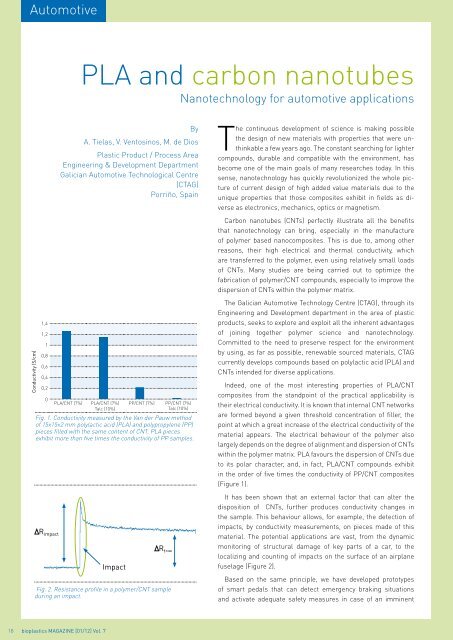bioplasticsMAGAZINE_1201
bioplasticsMAGAZINE_1201
bioplasticsMAGAZINE_1201
Create successful ePaper yourself
Turn your PDF publications into a flip-book with our unique Google optimized e-Paper software.
Automotive<br />
PLA and carbon nanotubes<br />
Nanotechnology for automotive applications<br />
Conductivity (S/cm)<br />
1,4<br />
1,2<br />
1<br />
0,8<br />
0,6<br />
0,4<br />
0,2<br />
0<br />
By<br />
A. Tielas, V. Ventosinos, M. de Dios<br />
Plastic Product / Process Area<br />
Engineering & Development Department<br />
Galician Automotive Technological Centre<br />
(CTAG)<br />
Porriño, Spain<br />
PLA/CNT (7%) PLA/CNT (7%)<br />
Talc (10%)<br />
PP/CNT (7%) PP/CNT (7%)<br />
Talc (10%)<br />
Fig. 1. Conductivity measured by the Van der Pauw method<br />
of 15x15x2 mm polylactic acid (PLA) and polypropylene (PP)<br />
pieces filled with the same content of CNT. PLA pieces<br />
exhibit more than five times the conductivity of PP samples.<br />
R impact<br />
Impact<br />
R t=∞<br />
Fig. 2. Resistance profile in a polymer/CNT sample<br />
during an impact.<br />
The continuous development of science is making possible<br />
the design of new materials with properties that were unthinkable<br />
a few years ago. The constant searching for lighter<br />
compounds, durable and compatible with the environment, has<br />
become one of the main goals of many researches today. In this<br />
sense, nanotechnology has quickly revolutionized the whole picture<br />
of current design of high added value materials due to the<br />
unique properties that those composites exhibit in fields as diverse<br />
as electronics, mechanics, optics or magnetism.<br />
Carbon nanotubes (CNTs) perfectly illustrate all the benefits<br />
that nanotechnology can bring, especially in the manufacture<br />
of polymer based nanocomposites. This is due to, among other<br />
reasons, their high electrical and thermal conductivity, which<br />
are transferred to the polymer, even using relatively small loads<br />
of CNTs. Many studies are being carried out to optimize the<br />
fabrication of polymer/CNT compounds, especially to improve the<br />
dispersion of CNTs within the polymer matrix.<br />
The Galician Automotive Technology Centre (CTAG), through its<br />
Engineering and Development department in the area of plastic<br />
products, seeks to explore and exploit all the inherent advantages<br />
of joining together polymer science and nanotechnology.<br />
Committed to the need to preserve respect for the environment<br />
by using, as far as possible, renewable sourced materials, CTAG<br />
currently develops compounds based on polylactic acid (PLA) and<br />
CNTs intended for diverse applications.<br />
Indeed, one of the most interesting properties of PLA/CNT<br />
composites from the standpoint of the practical applicability is<br />
their electrical conductivity. It is known that internal CNT networks<br />
are formed beyond a given threshold concentration of filler, the<br />
point at which a great increase of the electrical conductivity of the<br />
material appears. The electrical behaviour of the polymer also<br />
largely depends on the degree of alignment and dispersion of CNTs<br />
within the polymer matrix. PLA favours the dispersion of CNTs due<br />
to its polar character, and, in fact, PLA/CNT compounds exhibit<br />
in the order of five times the conductivity of PP/CNT composites<br />
(Figure 1).<br />
It has been shown that an external factor that can alter the<br />
disposition of CNTs, further produces conductivity changes in<br />
the sample. This behaviour allows, for example, the detection of<br />
impacts, by conductivity measurements, on pieces made of this<br />
material. The potential applications are vast, from the dynamic<br />
monitoring of structural damage of key parts of a car, to the<br />
localizing and counting of impacts on the surface of an airplane<br />
fuselage (Figure 2).<br />
Based on the same principle, we have developed prototypes<br />
of smart pedals that can detect emergency braking situations<br />
and activate adequate safety measures in case of an imminent<br />
18 bioplastics MAGAZINE [01/12] Vol. 7


















